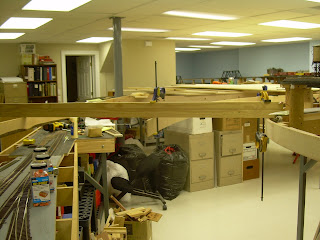


In order to give you the best understanding of our challenge, I took these photos looking back on the curved section. The first shot looks down the new aisle that we are creating. You can see the pine framing member on the temporary support at the lower left. This has to be tapered into the curved plywood in the center of the photo. You can just make out the gold clamp holding it up.
The second shot shows how we will be above the lower yard - it will become the hidden yard. You can see the framing on both sides of the yard.
The third photo shows this area from the other side, where you can see the bend in the 16 foot 1X4 that forms the outer member of the structure. I will be using the steel rod to hold this up as it crosses over the tracks in the foreground as it is very oblique and thus a long span.
The saga continues!











